Using Inversion Swings: Extensive Guide
Disclosure: We use affiliate links and may receive a small commission on purchases.
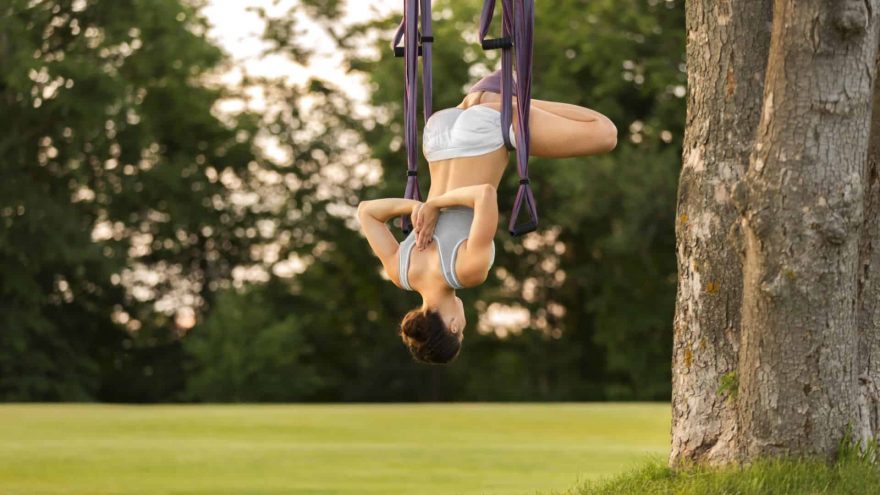 Using Inversion Swings: Extensive Guide
thefitbay.com
Using Inversion Swings: Extensive Guide
thefitbay.com
When it comes to chronic body pain, gravity is our worst enemy. Standing upright the entire day with a steady force pressing against us leaves many people with unbearable pain. And unfortunately, apart from a few lucky astronauts, most people never find themselves in zero gravity conditions where they can move with absolute freedom. Inversion swings, yoga swings, or aero slings – regardless of the way you choose to call them, allow us to close up on this experience in a fun, relaxing, and beneficial way.
Perhaps it comes as a surprise, but inversion swings have been around for a long time, at least the concept of them. The practice of inversion therapy dates a few thousand years back, when in Ancient Greece the first drawings of inverted yoga poses appeared. (1)
Yoga swings are fairly modern and a great way to enjoy the full benefits of inversion therapy without an expensive visit to a chiropractor or a healthcare professional. Incorporated into the traditional art of yoga by Tone Cardenas in 2001, yoga swings allow users around the world to swing in a variety of positions from the comfort of their own home and are generally safe and easy to use.
What Is an Inversion Swing?
Inversion swings are whatever you make of them; relaxation tools, exercise equipment, or a medical aid. Shaped similarly to a hammock, the only difference being the extended slings and a smaller saddle, inversion swings hang from a firm surface and are typically able to carry up to 275 pounds (125 kilos).
They usually consist of multiple ropes, handles, and chords which will allow you to freely move and place your body in the most unimaginable ways. When in the air, your pelvis will be supported and let you reposition your upper and lower body in all directions, strengthening a plethora of yoga poses you have or haven’t already mastered.
Inversion swings are appealing to people outside of the yoga community, too. Anyone who’s keen on eliminating the stress to their joints and skeletal system while adding variety to countless traditional yoga poses will surely throw an eye on this fascinating piece of equipment. Amateurs and professionals alike have found comfort, fun, and fitness value in inversion swings, adding a kick to their standard yoga routine.
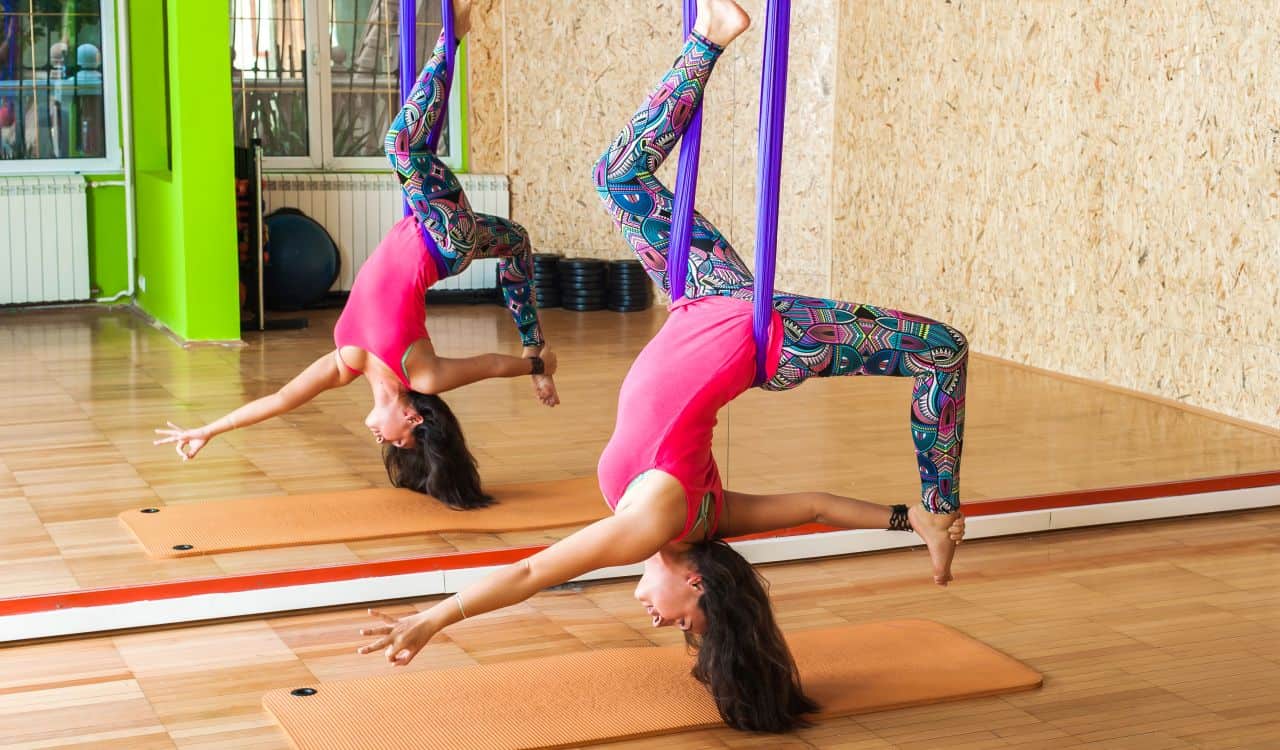
Also, what’s really great about inversion swings is their convenience. They commonly weigh under three pounds, meaning you should be able to fold one up in a gym bag and take it on a road without a drop of sweat. After unpacking it, simply find a suitable place to hook the slings and get going. But more on that later.
Types of Inversion Swings
Depending on their construction, there are two main types of inversion swings – yoga slings and trapeze swings. Now, as with every other href=”https://thefitbay.com/best-gravity-boots/”>fitness product, there are variations and you are likely to see tiny luxuries and gizmos on different models, such as arm and leg handles for increased convenience and security, for example.
Generally made of silk and synthetic fabric and coming with various types of saddles, inversion swings feature anything from triple handles on both sides to long drapes which add even more comfort to the user.
Expectedly, there will be countless shapes, materials, and colors to choose from. This will make individual swings hang off certain structures more easily; some will hook onto a door frame, others to large metal frames and ceilings, and then some will be compatible with a majority of surfaces.
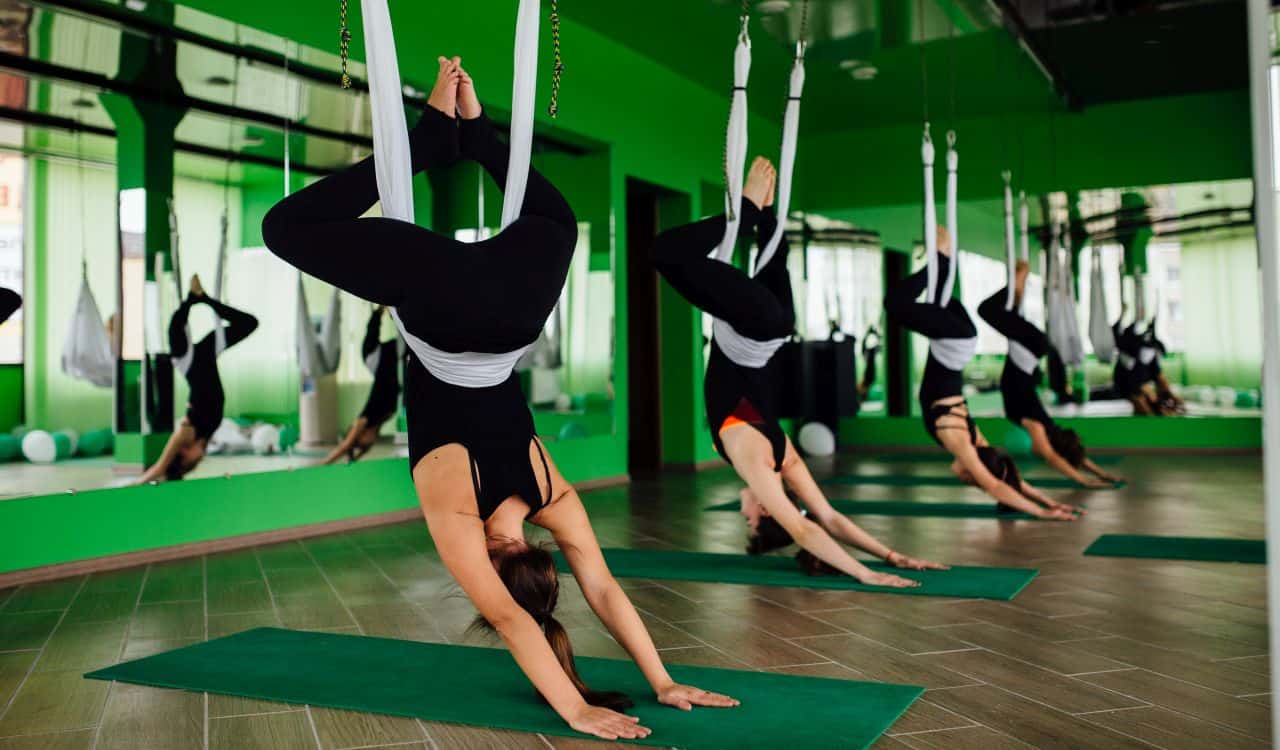
How to Use an Inversion Swing?
Using inversion swings is generally simple, but there are a few things you should keep in mind if you want to make your routine safe and enjoyable. First of all, wear comfortable clothes. The last thing you want to do is get into an inversion swing in a pair of jeans and shoes.
You need freedom of movement and these clothes aren’t exactly the definition of that. Unimpeded, fluid movement is imperative and will make your experience a smooth, effective, and cozy one. Take off all of your jewelry too, including earrings, chains, and rings to prevent them from getting all tangled up with the swings.
Instead, get yourself a pair of yoga pants, a soft tank top or a comfy t-shirt which will make for a light wear. Put your socks on if you feel like the floor is too cold to touch upon with your bare feet. Not that you’ll be touching it a lot!
Setting Up the Swing
First and foremost, choose enough space. Make sure there’s at least a square meter of space where you wish to install your inversion swing. The more the better. After you’ve selected a viable location, find a spot where you will hang your swing. It will work anywhere underneath a solid surface, your porch or your living room should do just fine. Yeah, even that tree branch in the garden is good.
Ensure the structure your swing will be hanging off is sturdy and reliable; if it’s a wooden beam, a solid, termite-free wood is a must. Always test that all is stable before going in and hanging upside down. Why? Yeah, you’ve guessed it right.
Warming Up
People tend to skip this part a lot, which sometimes proves a costly mistake. In order to minimize your chances of straining muscles and harming yourself, warm up. Full body, including neck, arms, legs, back, and abdomen. Stretch gently before moving onto some light warm-up exercises. This is because some yoga positions you might want to try out in your brand new inversion swing will be quite intense.
Get into Your Swing
When you’re ready to hop in the saddle of your swing, check if there are handles on the ropes and slings. By grabbing the handle upon getting into the swing you will have less difficulty keeping your balance and supporting your entry. If there are no handles, holding onto the swings will do just fine.
Squat above the saddle as you prepare to sit in. First, step over the saddle, one leg after the other, then settle yourself in. If the center is all jumbled, spread the material a little bit to get comfortable.
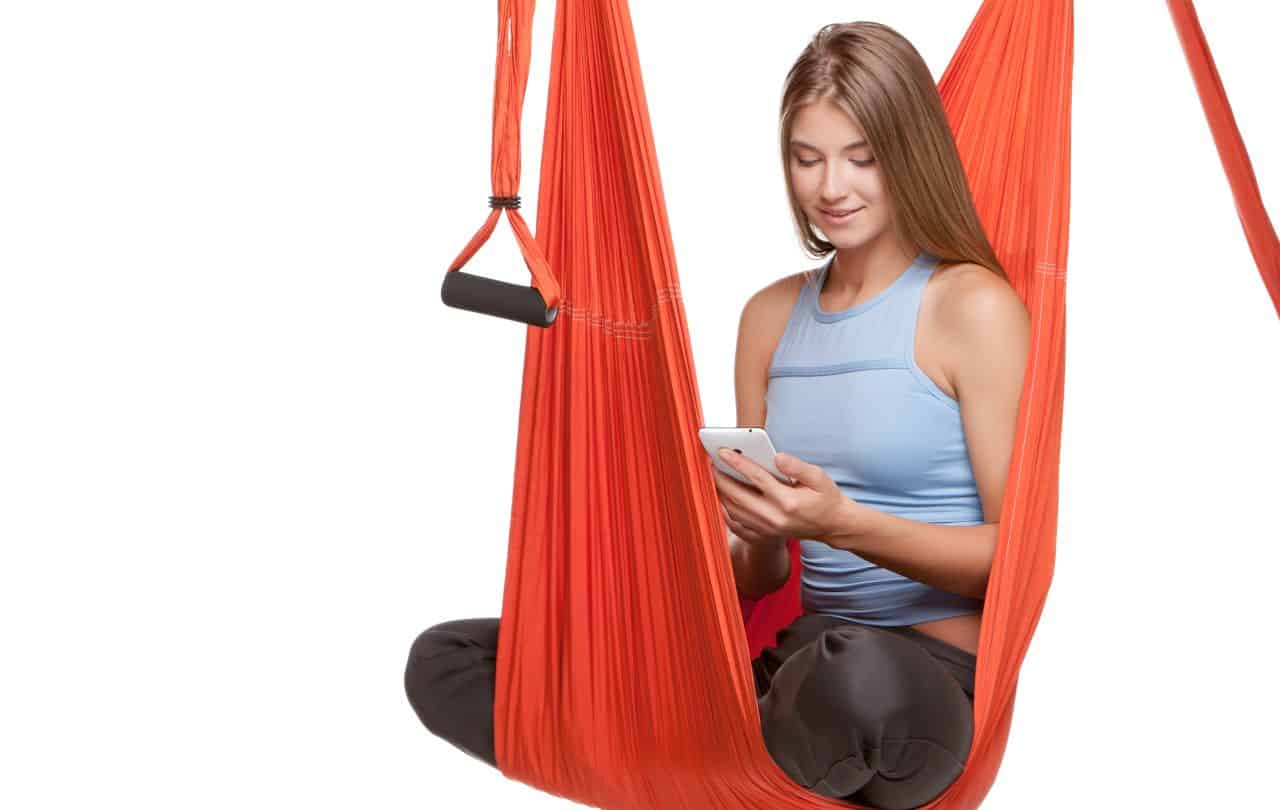
Try out Some Positions
Get to know your swing a little bit. Don’t rush it – try to move limbs first before setting to create an inversion. Once you’re ready, hold onto the swings with both hands and slide them along the material as you backbend just enough so that your pelvis is above your heart. Feel the swing’s construction supporting your movement and go easy; no sudden twitches. If it helps, hold and slowly release your breath as you go down. Keep it cool and relax your head and neck, allowing the body parts to take on a position of their own.
As you get better, you will find yourself experimenting more and more with the inversion swing. You will be surprised how little time it takes to find balance and master a plethora of relaxing and revitalizing exercises.
Bonus Tips
Here are some extra tips you may want to keep in mind when using an anti-gravity swing of any type:
- Drink plenty of water beforehand. Staying hydrated during intense exercises is one of the most crucial things you should remember.
- Have a snack at hand to keep your energy up.
- You’ll be in an upside-down position so remember not to eat any acidic foods or soda which will cause discomfort.
- Steer clear of lotion and skin lubricants which will reduce your grip and jeopardize your safety.
- Besides jewelry and watches, long nails can get tangled up with the swing, too.
- It is best to learn the ropes (no pun intended) in a professional environment. Book a session with a professional who will teach you the basics of aerial yoga.
How Long/Often Should I Invert For?
For best results and noticeable improvements, you should invert on a daily basis. Aim to fit in your sessions in the mornings, before meals and bedtime. As for the actual duration of your routine, remain in the swing for as long you feel comfortable, but the rule of thumb for beginners says 2-3 minutes should be enough.
As you become more adept in using the inversion swing, you will find your confidence grows and you’re spending more time in the saddle. This is great and shows your body is getting accustomed to a completely new position. The only thing to keep in mind is to wait for at least five breaths before you get out of your swing.
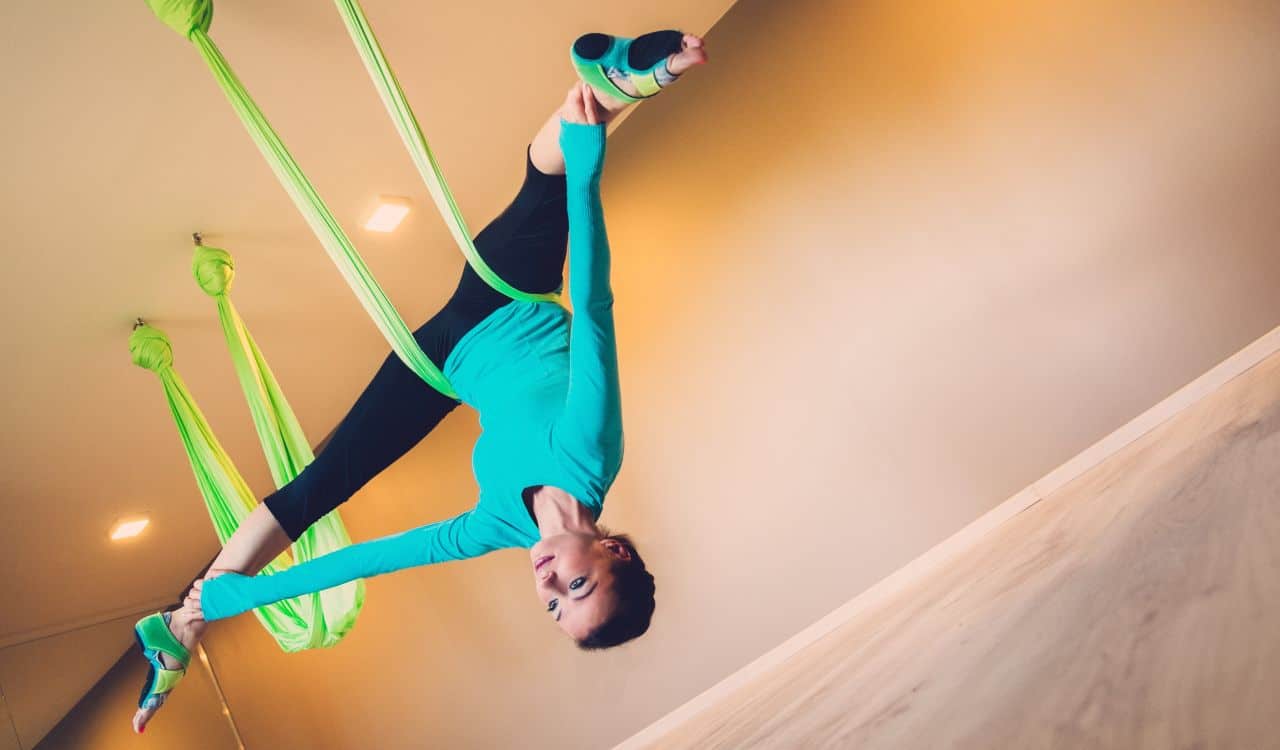
Safety First
As with all fitness tools, take special precaution if you’re particularly vulnerable to exercising. The dangers are even more profuse when it comes to inversion swings as your body’s cardiovascular system is under more pressure when you’re upside-down.
In short, think twice and consult with your healthcare professional before inverting if:
- You’re suffering from high blood pressure
- You have glaucoma
- Are menstruating (2)
Also, the inversion swing may not be your best option if:
- You have spinal issue
- Suffer from ear, head, neck, and sinus-affecting conditions
- Have cardiovascular difficulties
- Have issues with your torso and hip bones
Common Poses to Try Out
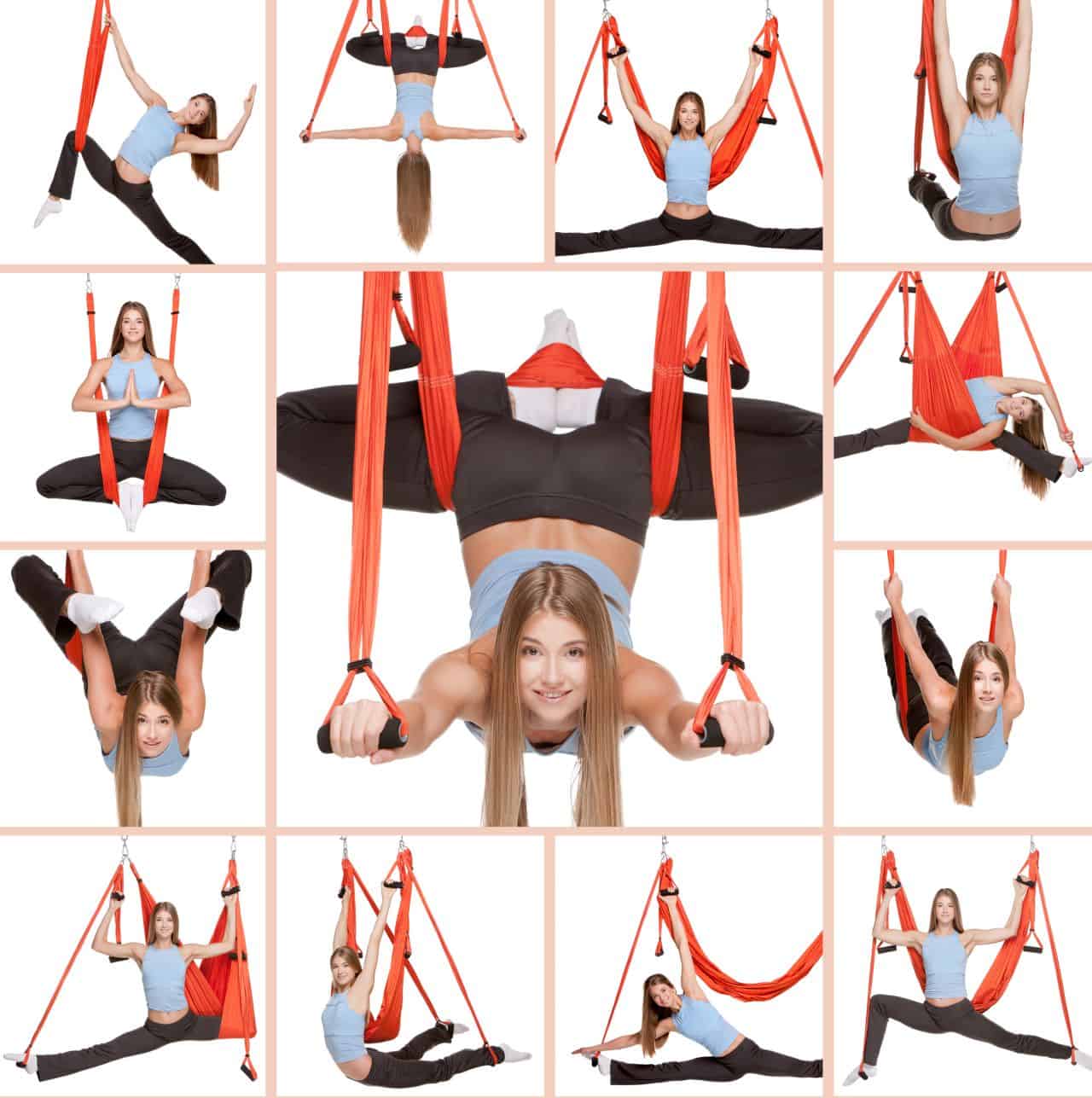
Warrior II
This basic sequence is perfect for beginners and those looking to enhance one of the most traditional yoga poses – the Warrior II. Use the trapeze swing to sit deeper in the saddle while you stretch out your lips in the forward direction. Here are the steps:
- 1. While standing in front of the swing, loop your arms through the sling.
- 2. Stretch your left foot out in a deep lunge and balance the posture out with the help of your arms.
- 3. Engage your back leg while keeping a 90-degree angle underneath your front knee.
- 4. Take 15 deep breaths with your gaze fixed forward.
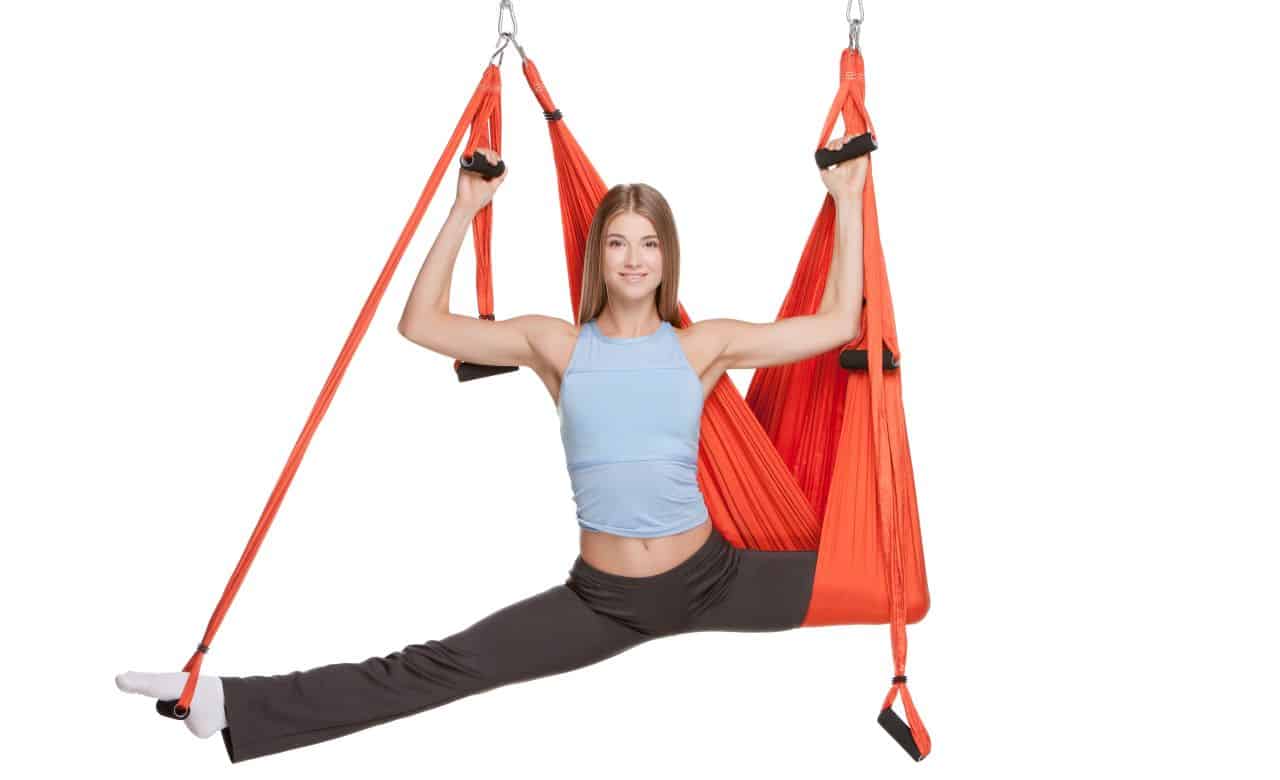
Warrior II Backbend
Use the trapeze swing to expand the front section of your body, all while keeping the standard Warrior II position.
- 1. Remain in Warrior II pose and slowly straighten your arms above the head, holding the ropes.
- 2. Lean back slowly, allowing your front to open up and your back to relax.
- 3. Open your eyes and keep a solid stance.
Trapeze Goddess
This pose opens up the section of your body where the heart is.
- 1. While keeping the Warrior II Backend pose, bring your left arm down where your leg calf is.
- 2. Lean to the side after grabbing the highest handle on the swing. While holding onto the handle, let your side fall and feel the stretch opening up your chest area.
- 3. Bring your head up and take 15 slow breaths.
Inverted Cobbler
Once you’re positioned comfortably in your swing, sitting down with limbs touching upon the floor, spread out your legs as far as possible. Then relax your arms and let them drop by your side as you lean back. You will feel the saddle supporting you as you flip and begin turning upside down.
In an inverted position, spread your arms out and rest them on the floor. Join your feet together while bending the knees sideways, so that they resemble frog’s legs. This is the final position. Now take 15 slow breaths and steadily go back to your prime position in reverse.
Pigeon Pose
This is the ultimate pose for your hips. Once you’re in your inverted cobbler position, secure your right leg by wrapping it around the rope. Stick your left leg underneath your right elbow to secure it in place while holding hands together for additional support. Whatever version of the pigeon pose you choose to do, take five long breaths when in final position and reverse all steps so that you can safely return to the primary position.
Possibilities are Endless
Of course, there are many more poses and exercises you can do in your inversion swing. Depending on your fitness level and skill, these will be either easy or difficult for you to do. Whether a beginner or a pro, you will find a plethora of resources and step-by-step instructions online.
Benefits of an Inversion Swing
Using an inversion swing brings numerous benefits to your mind and body. Not to mention the whole process is a fun and exciting one. After all, you’re hanging upside down in mid-air while all of your blood flows down to your brain. Who knew reversing the effect of gravity could be so much fun?
Decompresses Vertebrates and Joints
Besides the playful aspect of it all, exercising with inversion swings produces certain health benefits. Their potentially therapeutic effect has been studied extensively for its contributions to the nervous, endocrine, lymphatic, and perhaps most importantly – cardiovascular system. (3)
A reversed blood flow itself helps the heart while your spine decompresses as space between the vertebrates expands. This allows for an improved blood flow, improves the supply of nutrients, and helps with nerve pain.
Hanging upside-down means your bodily parts stretch in a way they haven’t been able to before. You can strengthen, relax and realign nearly every part of your body. Once you’re out of your inversion swing, you will immediately feel lighter, taller, and simply more refreshed. They say we’re a couple inches taller in the morning and by the evening our body literally shrinks in size. This is all on gravity and with an inversion swing, one can befriend gravity and make the most out of it.
Supports Several Bodily Systems
When you’re in an upside-down position (your pelvis is position above your heart), your immune system benefits from a better functioning as you stimulate your lymphatic system. In addition to this, inversion swings may also promote the functioning of the endocrine system by stimulating its numerous glands and their hormone production. This is also the reason why inversion swings are a great tool for women in menopause and perimenopause.
Relieves Back Pain
As you probably know already, gravity, though not a direct cause of our back pain, contributes to it significantly. Nowadays, people tend to sit at their desk job the entire day, rendering their spine and muscles inactive. Driving all day or standing on your feet produces similar effects and often results in back pain which can range from mild and moderate to severe and unbearable.
What inversion swings do is they realign your skeletal system, including your spine and back by allowing gravity to free up space between the vertebrates. (4) This takes a lot of pressure off the discs, ultimately resulting in less back pain. For example, sciatica, a common back pain type is caused by a narrow spinal canal and compressed discs in the lower back area of the body. This is also how people start developing nerve pain in their leg.
The decompression of the spine which inversion swings spark brings relief from sciatica and many similar conditions, such as muscle pain, disc compression, and stiffness. As long as your hips are above your heart level the blood flow will be reversed and you will be able to self-address and treat problems such as muscle tension in certain areas, neck and back pain, as well as improve your flexibility and circulation.

Increases Blood Flow to the Brain
The sensation of blood rushing down your body and into your brain may seem a little strange at first but you will notice almost immediately how your brain feels more active and alive. Don’t forget your brain is extremely oxygen-hungry and more blood also means more oxygen brought by the hemoglobin on the red blood cells. This can lead to an improved cognitive functioning, increased focus, and balance, as well as a clearer mindset. (5)
Reduces Stress and Muscle Tension
A study by a physiotherapist L.J Nosse suggests muscle tension reduced by more than a third in the first 10 seconds of inversion, even at a very shallow angle of 25 degrees. The rationale behind the findings was that the improved blood circulation caused by the inversion brought more oxygen-rich blood into the tense muscle areas, enabling them to stretch fully. (6)
In addition, the effect inversion swings create stimulates the lymphatic system and clears the muscles from toxins that impede proper functioning. Some researchers believe that this muscle-relaxing property of inversion is the reason behind its significant back and neck pain reduction.
Builds Core Strength
Another benefit stemming from hanging upside down on a yoga swing is your ability to exercise with the help of the same. For most people crunches are cumbersome and plain boring but inversion swings provide a fun, new way of exercising and even add more resistance as you’re up in mid-air with no ground support whatsoever.
There is a wide range of movements on a yoga swing that you can incorporate into your routine for a more effective workout session. From building your core and upper body strength to working on your endurance, yoga swings can provide an exciting environment for countless of exercises.
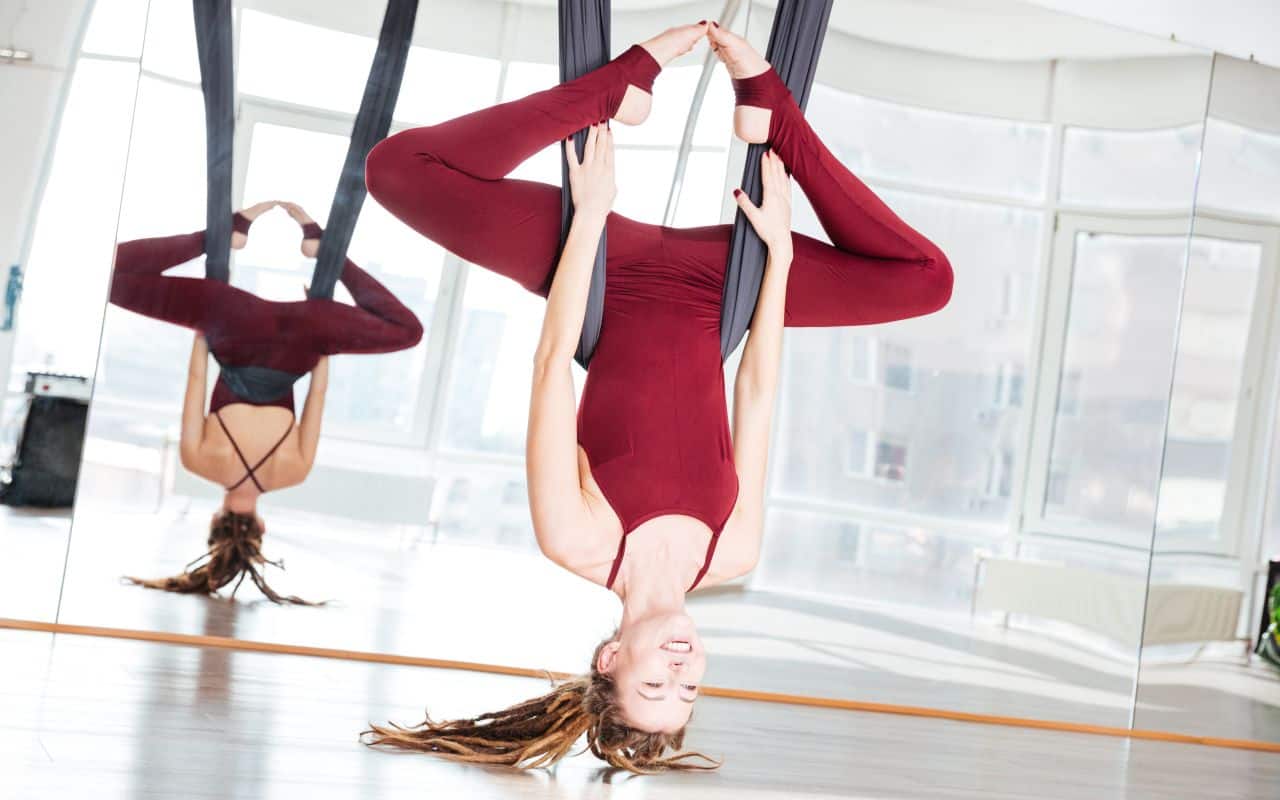
Benefits of Inversion Swings in Short
- Inversion swings make you feel more energized and awake by increasing blood flow to your brain in a completely natural way. Instead of reaching for stimulants such as caffeine and nicotine, why not spend a few minutes hanging off the inversion swing?
- Transferring traditional yoga poses into the inverted environment stabilizes your balance and improves flexibility.
- Inverted positions may help you relax and see the world from a different point of view.
- Practicing yoga positions on an inversion swing is a great way of boosting your immune system, among other vital systems.
- One can build his or her core strength by exercising with the help of an inversion swing.
- Inverted poses help with back and neck pain by providing decompression of the spine and the skeletal system.
- Moving into yoga positions in an inversion swing may reduce muscle tension and stiffness.
In addition to the benefits listed above, hanging upside down is also a lot of fun! If you plan on using inversion swings for exercising or wish to incorporate your yoga routine into a new and exciting environment, why not check our buying guide on the best inversion swings currently on the market?




